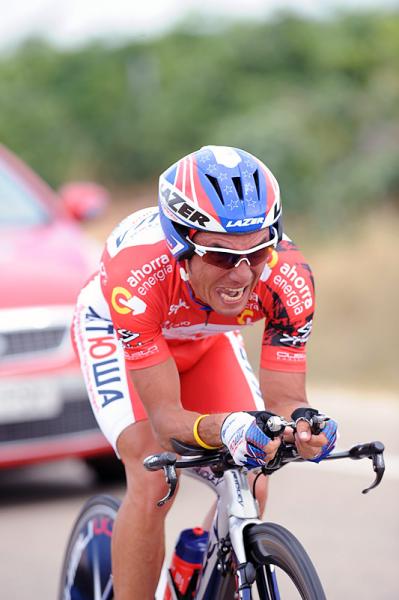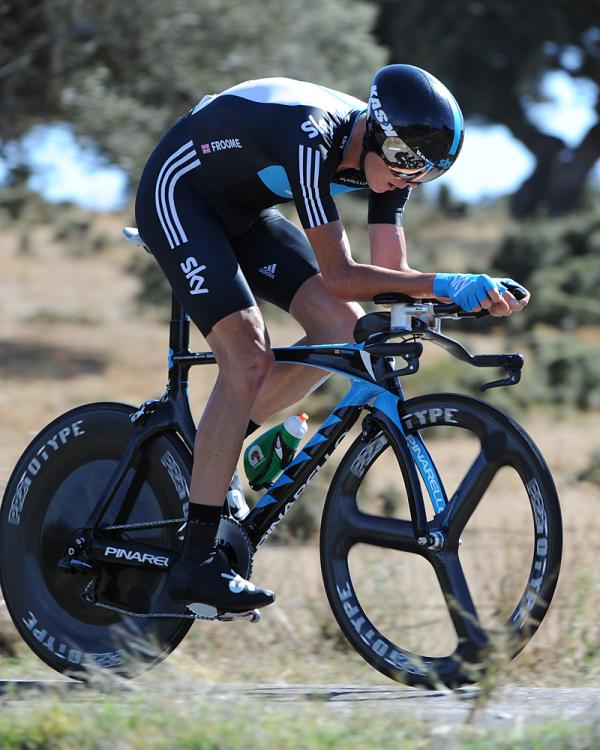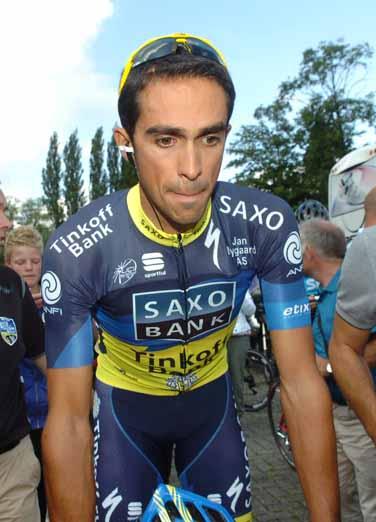Vuelta time trial course breaks with past
Cyclingnews TT recon: highly technical, very hilly and a nasty descent



Remember when the Vuelta a España time trial courses used to specialize in flat, featureless motorway routes running through flat, featureless desert, with only the odd sign informing you there was 100 kilometres to go to the next exit to break the monotony?
Zaragoza 2007 was probably the most (least) memorable of those: on a 52.2 kilometre motorway course running through semi-desert with no hills and virtually no corners where future world time trial champion Bert Grabsch used a massive gear to destroy the field. All credit to Grabsch’s racing, but it was about as interesting to watch as paint drying.
In 2010 we had Peñafiel, which was flat and straight, but at least had massive vineyards as a backdrop to keep us from getting bored, and in 2011 at Salamanca, it was rolling and straight and there was the surprise of Chris Froome (Sky) taking the lead to maintain the interest, but we were back to semi-desert and burned out cornfields as a backdrop. Either way, until the results came in, they were still courses where much churning of large gears and a correspondingly high tum-ti-tum factor was the order of the day.
Anyway, if Wednesday’s stage 11 time trial is anything to go by, those times are very much behind us. In 39.4 kilometres of racing between Cambados and Pontevedra, there are perhaps two stretches of 500 metres in the entire course that could be defined as straightaways.
The rest is a non-stop blur of corners, climbs, scary descents, hairpin bends, and rolling terrain, all on roads that are ‘A’-road quality at best, which makes it a real test of technical ability rather than pure power. There’s even a cobbled section somewhere in there. The only motorway in sight is just before the main third category climb, the Monte Castrove. But seeing the motorway is the closest the time trial gets. And in the final third of racing, the scenery overlooking the Atlantic bays and verdant mountains of western Galicia when the race drops down from Castrove to Pontevedra is nothing short of breathtaking – provided it doesn’t rain, as is often the case here.
The cyclists, on the other hand, will have few opportunities to catch their breath, from the moment the race leaves the coastal resort of Cambados. Plunging inland on backstreet roads, the first 13 kilometres begin with twisting urban roads, switch briefly to some more rollercoaster terrain through a wood and then return to more suburb-like territory, complete with roundabouts, traffic passes and sudden changes of direction. If you’re wondering who most of the road graffiti is in favour of, by the way, it’s Gustavo Cesar Veloso (Andalucia), the only locally born rider in the peloton and winner of the Volta a Catalunya way back in 2008 when a freak rainstorm shattered the bunch on the last, theoretically easy, stage into Barcelona.
Up until this point, the changes in altitude are nothing too complicated. But as 2011 Vuelta winner Juan José Cobo (Movistar) pointed out yesterday, “the time trial is all about the climb” and given the Alto de Monte Castrove is a 10 kilometre (yes, you read that right, 10 kilometre) ascent, he’s hit the nail on the head.
The latest race content, interviews, features, reviews and expert buying guides, direct to your inbox!
Although not excessively steep (averaging 4.4 percent, with 447 metres of climbing), the climb makes up for over a quarter of the entire TT. The slopes are punishingly steady and constantly curving left and right for the first six kilometres, and there are just a couple of segments where it eases off slightly. Into the last four kilometres, whilst much straighter, the gradient continues to rise relentlessly to 490 metres above sea level before a sudden righthand turn indicates the descent has begun.
There are stunning views of the Pontevedra bay below at this point, but given the road for the drop down is in far worse condition than on the smooth, well-surfaced ascent, the chances are the riders won’t be looking. Three really sharp hairpin bends, poorly cambered turns, rough tarmac and a narrow, twisting road that plunges down at breakneck speeds through a wood will make for a very fast, complicated descent. When Chris Froome said “it’s very technical and we will have to be careful,” he wasn’t kidding. If it rains, this could be dangerous.
The last eight kilometre chunk is relatively straightforward – a sudden kick up after that fast descent, a rollercoaster ride through woodland, another fast drop to Pontevedra and a couple of kilometres through the streets of the finish town before the course is complete.
Calculating how much energy to leave for after the climb will be just one factor that guarantees a degree of success, as will bike handling skills and staying upright on that descent. It says a lot about how technical a course it is that Veloso, who says he knows “every metre” of it, is expected to finish in the top ten, purely as a result of his local knowledge. Amongst the favourites, reigning World Champion Tony Martin (Omega Pharma-Quick Step) and winner of last year’s Vuelta time trial is one top candidate, although most of the interest will centre on its consequences on the battle for the overall classification between the race’s big four – Alberto Contador (Saxo Bank-Tinkoff Bank), Alejandro Valverde (Movistar), Chris Froome (Sky), and Joaquim Rodriguez (Katusha). Sports daily MARCA described the time trial as “Galician roulette” and a course like this certainly could turn up some unpredictable results.
Alasdair Fotheringham has been reporting on cycling since 1991. He has covered every Tour de France since 1992 bar one, as well as numerous other bike races of all shapes and sizes, ranging from the Olympic Games in 2008 to the now sadly defunct Subida a Urkiola hill climb in Spain. As well as working for Cyclingnews, he has also written for The Independent, The Guardian, ProCycling, The Express and Reuters.

